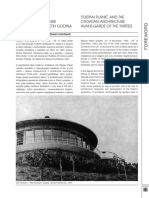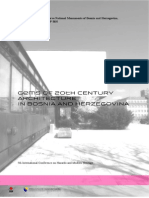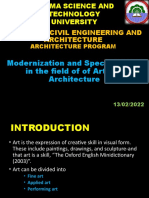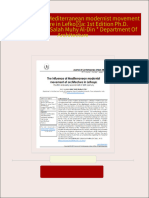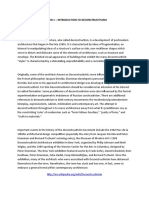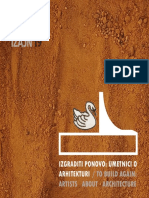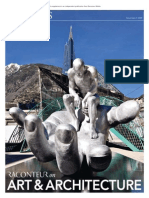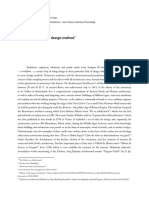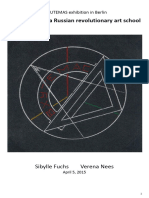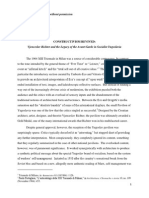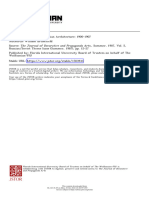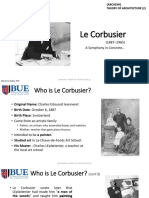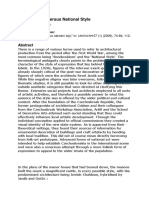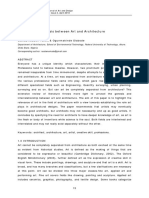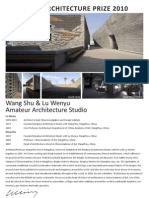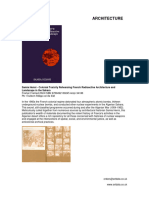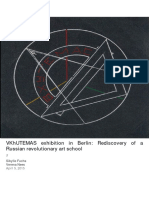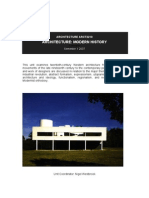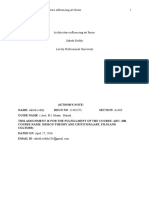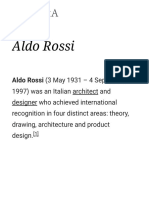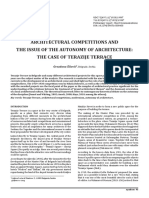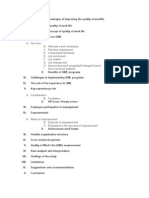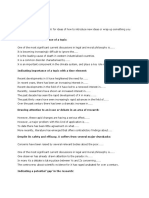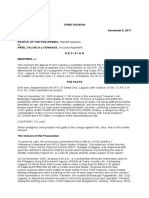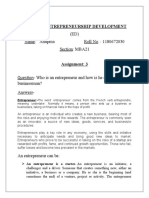Ap08 1 6
Ap08 1 6
Uploaded by
Tomislav TabainCopyright:
Available Formats
Ap08 1 6
Ap08 1 6
Uploaded by
Tomislav TabainOriginal Title
Copyright
Available Formats
Share this document
Did you find this document useful?
Is this content inappropriate?
Copyright:
Available Formats
Ap08 1 6
Ap08 1 6
Uploaded by
Tomislav TabainCopyright:
Available Formats
Acta Polytechnica Vol. 48 No.
1/2008
REVIEW
Moderna arhitektura u hrvatskoj 1930–IH
Modern Architecture in Croatia 1930’s
by Darja Radović Mahečić
A. Bičík
Keywords: Croatian modern architecture, functionalism, functionalism in Croatia
In May 2007 Institut za povijest umjetnosti (The Institute
of Art History) in Zagreb released an academic publication
about the topography of modern architecture from the pe-
riod between the two World Wars on the territory of Croatia.
The book was produced by the Školska knjiga publishing
house, supported by the International Working Party for Docu-
mentation and Conservation of Buildings, Sites and Neighbourhoods
of the Modern Movement (DoCoMoMo), founded in 1988 in
Eindhoven. DoCoMoMo works on revitalizing and promot-
ing 20th century modernist art.
This book presents the results of a five – year project un-
der the direction of Darja Radović Mahečić from the Institute
for Art History in Zagreb. In the course of the project a na-
tional register of Croatian modern architecture from the pe-
riod between 1926 and 1940 was set up. The task was to inves-
tigate this period of Croatian architecture, when a national
identity was being created and many buildings and con-
ceptswere being developed under the influence of political
changes, comparable to events in the traditional European
architectural centres. The one hundred selected buildings
represent a broad spectrum of types: public spaces, offices,
residential and multifunctional buildings, rental villas and
family houses, schools, hospitals, hotels, churches and cha-
pels, exhibition pavilions and workers’ districts. Some show
close links with local tradition (e.g., the Institute for Biology
and Oceanography in Split, by Fabjan Kaliterna, 1930–1931)
mainly on the Croatian coastline. After Zagreb, the other cul-
tural centres were Split, also Rijeka and Zadar, which were un-
der Italian rule. Modern architecture also reached the islands
of Krk, Hvar, Koločep and Lopud, and also the architecturally Book jacket
preserved town of Dubrovnik (see City Café and cinema at the
Great Arsenal, by Mladen Kauzlarić and Stjepan Gomboš, or architects, time of creation and address), black-and-white,
1931 – 1933). illustrations (original and current photos, in some cases re-
The structure of the book is clear and well–arranged. productions of plans and sketches) and an index of sources.
After the introduction there are chapters on Croatian Modern The preconditions for inclusion in the catalogue were that the
Architecture in the 1930s and The Internationalization of Croatian source documentation had been well researched, the build-
Architectural Avant-Garde, followed by a Register of Modern Ar- ings were of highly architectural value, and above all, that
chitecture in Croatia, a bibliography, a typological index, and an their present condition and appearance reveals the original
index of localities and names. The core material is a catalogue architectural and urban concept.
of one hundred selected and in chronologically ordered ex- The third condition must have been complicated by the
amples of modern architecture in Croatia. Each building is fact that many examples have been damaged e.g., by removal
presented here with its main specifications (name, architect of the flat roof, a typical formal feature. Nevertheless, these
© Czech Technical University Publishing House http://ctn.cvut.cz/ap/ 43
Acta Polytechnica Vol. 48 No. 1/2008
later became a world-famous sculptor. Sixty students gradu-
ate from this school before it closed in 1942. In 1920 the
Croatian Society of Civic Engineers and Architects accepted
new rules for architectural competitions, including a commit-
ment to arrange competitions for every General Master Plan
(see international competitions for the General Master Plans
of Zagreb and Split, 1931–1936) and for every public build-
ing. This contributed to the diffusion of modern architecture
to distant regions. The existence of two architectural schools
competing with each other was good for the development of
Croatian modern architecture. One of the artists’ associations,
Zemlja, is introduced here. It was founded by the painter Krsto
Hegedušić in 1929, at the Academy of Fine Arts in Zagreb.
The architect Drago Ibler headed the association and was also
the author of its manifesto. The group wanted to promote art
that reflected the modern vital needs of Croatian society.
They put this into practice through public lectures, exhibi-
tions and cooperation with similar intellectual groups. Before
Ivan Zemljak:
Trešnjevka Municipal Primary School, Zagreb, 1930–1931
it was banned in 1935, the group held seven exhibitions with
permanent and guest members. Almost all architects had at-
buildings are on the list, because they are important for the
development of modern architecture in Croatia.
In the chapter Croatian Modern Architecture in the 1930s
(p. 16–32) the author talks about historical context of Croatia
and about the development of the Croatian school architec-
tural system. This opening chapter goes on to show interna-
tional and local architectural and urban design competitions,
the problem of artists’ associations and their programmes,
and contemporary evaluations of the new modern archi-
tecture. The question of urban planning is then analysed.
The towns encountered new problems, e.g., the rising of
population in the towns, and the design of large municipal
structures, rather than small flats. Next the book introduced
some revolutionary events in the field of architectural educa-
tional the foundation of two architectural schools. The author
describes the foundation of the Royal Technical College in
Zagreb in 1919. The establishment of this school had been
under preparation by the Croatian Society of Civic Engineers Marijan Haberle:
and Architects since 1898. Its first rector was Edo Šen (Schön) Church of Blessed Marko Křiževčanin, Zagreb, 1940
and the first graduate was Alfred Albini. The second school to
be founded was the Department of Architecture, in 1926, at tended Ibler’s course at the Academy.
the Academy of Fine Arts in Zagreb, under the direction of The chapter on The Internationalization of Croatian Archi-
Drago Ibler. At that time the rector was Ivan Meštrović, who tectural Avant-Garde (p. 33–53) tells about the contacts of
Croatian architects with the association Congr s Internationaux
d’Architecture Moderne (CIAM) and important architects from a
number of European art centers (Vienna, Dresden, Frankfurt,
Berlin, Budapest and Prague). The author draws attention to
the reflections of Croatian modern architecture at interna-
tional exhibitions and in technical papers published inside
the Kingdom of Serbians, Croatians and Slovenes and else-
where in Europe. The main journals are Tehni ki list (pub-
lished in Zagreb), Arhitektura (founded in Ljubljana in 1931),
Gradevinski vjesnik (founded in Zagreb in 1932), the Ger-
man reviews Bauwelt and Monatshefte für Baukunst, the French
review L’Architecture d’aujourdhui. The book mentions promi-
nent architects who studied outside Yugoslavia, e.g. Prague-
students Nikola Dobrović, Marko Vidaković, Ivan Zemljak
and Zvonimir Kavurić, Vienna student Juraj Neidhardt and
Ernest Weissmann who worked with Le Corbusier. Le Cor-
Fabjan Kaliterna: busier helped him to become the first resident CIAM repre-
Institute for Biology and Oceanography, Split, 1930–1931 sentative of Yugoslavia. Many other architects returned to
44 © Czech Technical University Publishing House http://ctn.cvut.cz/ap/
Acta Polytechnica Vol. 48 No. 1/2008
Yugoslavia from major European studios led by Le Corbusier, facade bricks with details in concrete and flat roofs. The
Josef Hoffmann, Adolf Loos, Peter Behrens or Hans Poelzig. town housed 1818 people in 1936. In the midst of the public
Other architects took part in architectural competitions buildings there is a hostel for single workers with 200 beds, a
abroad, e. g., Juraj Neidhardt and Vladimir Potočnjak partici- primary school, a professional secondary school, a depart-
pated in the architectural competition for the workers’ district ment store, a restaurant, a cinema, a stadium and sports
in Zlín, Czech Republic in 1935, and Potočnjak was awarded airport. At the peak of its expansion in 1939, the factory em-
one of the prizes. ployed 6290 workers of whom 4650 lived in the town. After
The Register of Modern Architecture in Croatia (p. 58–467) 1945 the town was renamed to Borovo. The complex was
includes some important Czech architects and their works on damaged in Yugoslav army attacks in 1991. Restoration work
the territory of Croatia and also several of their Croatian col- has taken place since 1998, unfortunately without the value of
leagues who studied in Prague. We are introduced to theVilla the original structures.
Pfefferman (which now houses the embassy of the Czech Re- The book Moderna arhitektura u Hrvatskoj 1930 – ih informs
public) in Zagreb. This project from 1928 – 1929 was led by readers about the birth and development of Croatian modern
Marko Vidaković, who studied in Vienna and Prague, where architecture in the 1930s. Profiles of 100 buildings form the
he graduated in 1918. He and his schoolfellows Ivan Zemljak central material in this publication, the profiles are rich in
and Vladimir Šterk they are considered to be the architects iconic documentation and information about sources, and
who designed the first modern buildings in Zagreb. Czech these make it valuable not only for researchers but also for
architect Josef Kodl designed the municipal schools in Split practicing architects. The effort to promote the modern
1928–1930. The most important work alluding to Czech ar- architecture of this period through one hundred selected
chitecture is the Bataville satellite industrial town of the Bat’a houses is laudable. However, a book covering all the findings
shoe factory in the neighborhood of Vukovar, by architects of Darja Mahečić’s team and providing a compact insight into
František Lydie – Gahura (general master plan), Vladimír all structures includes in the national register of Croatian
Karfík and Antonín Vítek (architectural design of houses) modern architecture would be of even greater value.
1931–1938. The project included 13 six – storey indus-
trial blocks sized 80×20 m, according to the Bat’a’s Zlín
Hall no. 24, with the skeleton of reinforced concrete with Ing. arch. Aleš Bičík
6.15 m×6.15 m modules and large windows. The residential e–mail: a.bicik@post.cz
quarter built before 1936 was named after Jan Bat’a. The Department of Monuments Protection and Renovation
quarter contained 122 apartment buildings, located in the
park belt, with 421 dwelling units: 17 family houses for di- Czech Technical University in Prague
rectors and engineers, 8 two – apartment houses for top Faculty of Architecture
managers and 97 four-apartment buildings for workers. The Thákurova 7
houses were cubic in form and were made of unplastered 166 34 Prague 6, Czech Republic
© Czech Technical University Publishing House http://ctn.cvut.cz/ap/ 45
You might also like
- Jean-Louis Cohen - Exhibitionist Revisionism - Exposing Architectural History (September 1999)Document10 pagesJean-Louis Cohen - Exhibitionist Revisionism - Exposing Architectural History (September 1999)Javier PerezNo ratings yet
- "Varsovie Radieuse. Return of Le Corbusier To Za Żelazną Bramą" Exhibition BrochureDocument28 pages"Varsovie Radieuse. Return of Le Corbusier To Za Żelazną Bramą" Exhibition BrochureCentrum Architektury100% (1)
- Studies in Tectonic Culture PDFDocument14 pagesStudies in Tectonic Culture PDFF ANo ratings yet
- Lesson Plan (Literature: Poetry)Document2 pagesLesson Plan (Literature: Poetry)Muhammad Fariz bin Pugal85% (13)
- Portrait of Mona LisaDocument2 pagesPortrait of Mona Lisamae sherisse caayNo ratings yet
- Stjepan Planic Katalog Izlozbe 005 015 UvodnikDocument11 pagesStjepan Planic Katalog Izlozbe 005 015 Uvodnikvedran1980100% (1)
- Stjepan Planic - Katalog Izlozbe - 029 054 - Treba ZnatiDocument26 pagesStjepan Planic - Katalog Izlozbe - 029 054 - Treba ZnatiZoran MaranovićNo ratings yet
- Dragulji KatalogDocument70 pagesDragulji KatalogAlma Husić100% (1)
- Art Architecture and Urbanism in DialogueDocument65 pagesArt Architecture and Urbanism in DialogueMikias TadesseNo ratings yet
- Corbus HandsDocument10 pagesCorbus HandsSCRIBDUSNo ratings yet
- Leonidov Institute of StatisticsDocument11 pagesLeonidov Institute of StatisticsBarNo ratings yet
- 91111Document40 pages91111liximagauNo ratings yet
- Download Full The influence of Mediterranean modernist movement of architecture in Lefkoşa: 1st Edition Ph.D. Candidate Salar Salah Muhy Al-Din * Department Of Architecture PDF All ChaptersDocument40 pagesDownload Full The influence of Mediterranean modernist movement of architecture in Lefkoşa: 1st Edition Ph.D. Candidate Salar Salah Muhy Al-Din * Department Of Architecture PDF All Chaptersspachjaffakp100% (5)
- The Influence of Mediterranean Modernist Movement of Architecture in Lefkoşa: 1st Edition Ph.D. Candidate Salar Salah Muhy Al-Din Department of Architecture Ebook All Chapters PDFDocument40 pagesThe Influence of Mediterranean Modernist Movement of Architecture in Lefkoşa: 1st Edition Ph.D. Candidate Salar Salah Muhy Al-Din Department of Architecture Ebook All Chapters PDFdefauxhalawi100% (15)
- 02 Literature SurveyDocument37 pages02 Literature SurveyAditya WallabhNo ratings yet
- Daniel Libeskind and Aspects of Contemporary Jewish ArchitectureDocument13 pagesDaniel Libeskind and Aspects of Contemporary Jewish ArchitectureGál-Jäger HenriettaNo ratings yet
- Modernism of Scarcity Architect Milan ZLDocument16 pagesModernism of Scarcity Architect Milan ZLIvan MarkovicNo ratings yet
- The Influence of Le Corbusier On The Emergence of The Aesthetic Values in The Modern Architecture of CyprusDocument12 pagesThe Influence of Le Corbusier On The Emergence of The Aesthetic Values in The Modern Architecture of CyprusJournal of Contemporary Urban AffairsNo ratings yet
- Ilijevski A - Cvijeta Zuzoric Pavilion Exhibitions PDFDocument17 pagesIlijevski A - Cvijeta Zuzoric Pavilion Exhibitions PDFMarija PokrajacNo ratings yet
- Artists About ArchitectureDocument52 pagesArtists About ArchitectureSonjaO'JankovNo ratings yet
- Raconteur Media: Art & ArchitectureDocument16 pagesRaconteur Media: Art & ArchitectureianbanksNo ratings yet
- Modern Architecture and The Mediterranean Vernacular Dialogues and Contested IdentitiesDocument5 pagesModern Architecture and The Mediterranean Vernacular Dialogues and Contested IdentitiesmglyzinaNo ratings yet
- Theatre Space After 20th CenturyDocument283 pagesTheatre Space After 20th Centurydragana_k100% (7)
- Theater Space Proceedings 2011Document285 pagesTheater Space Proceedings 2011NinaAultNo ratings yet
- Modern Serbian ArchitectureDocument13 pagesModern Serbian ArchitectureStevan SapundzicNo ratings yet
- Posebni Otisak /: Separat OffprintDocument18 pagesPosebni Otisak /: Separat OffprintDžumhur LejlaNo ratings yet
- Restoring Art Nouveau 2019Document116 pagesRestoring Art Nouveau 2019Gábor PappNo ratings yet
- Pattern Language - Design Method - Aleksander T. ŚwiątekDocument6 pagesPattern Language - Design Method - Aleksander T. ŚwiątekAlexSaszaNo ratings yet
- VKhUTEMAS Exhibition in BerlinDocument57 pagesVKhUTEMAS Exhibition in BerlinLudwig SzohaNo ratings yet
- Constructivism Revisited - Vjenceslav Richter and An Avant-Garde Architecture For An Avant-Garde Soci - Vladimir KulicDocument13 pagesConstructivism Revisited - Vjenceslav Richter and An Avant-Garde Architecture For An Avant-Garde Soci - Vladimir KulicIvan MrkvcNo ratings yet
- Russia 1900 1907Document17 pagesRussia 1900 1907LarisaNo ratings yet
- The NER Project: A Vision of Post-Industrial Urbanity From Post-Stalin RussiaDocument25 pagesThe NER Project: A Vision of Post-Industrial Urbanity From Post-Stalin Russialou CypherNo ratings yet
- R Alcayde The Discussion Is Not OverDocument8 pagesR Alcayde The Discussion Is Not OverTitan XalNo ratings yet
- ARTICULO PALLINI - Schools and Museums in Greece PDFDocument13 pagesARTICULO PALLINI - Schools and Museums in Greece PDFIsabel Llanos ChaparroNo ratings yet
- L06 Le Corbusier 2022-2023Document59 pagesL06 Le Corbusier 2022-2023Maria HanyNo ratings yet
- 07 Zunic PDFDocument30 pages07 Zunic PDFkuravNo ratings yet
- Rondocubism Versus National Style: Vendula HnídkováDocument27 pagesRondocubism Versus National Style: Vendula HnídkováGábor PappNo ratings yet
- The Alfragide Towers 1968 74 by AtelierDocument15 pagesThe Alfragide Towers 1968 74 by AtelierJuliana Monteiro BalageNo ratings yet
- Comparative Analysis Between Art and Architecture: OMALE Reuben Peters & Ogunmakinde OlabodeDocument18 pagesComparative Analysis Between Art and Architecture: OMALE Reuben Peters & Ogunmakinde OlabodeNathasha KudasingheNo ratings yet
- Comparative Analysis Between Art and Architecture: OMALE Reuben Peters & Ogunmakinde OlabodeDocument18 pagesComparative Analysis Between Art and Architecture: OMALE Reuben Peters & Ogunmakinde OlabodeNathasha KudasingheNo ratings yet
- Critical RegionalismDocument5 pagesCritical RegionalismKritika PanwarNo ratings yet
- Ivan Antic DMDocument7 pagesIvan Antic DMBojana BozicNo ratings yet
- Schelling Architecture Prize 2010: Wang Shu & Lu Wenyu Amateur Architecture StudioDocument6 pagesSchelling Architecture Prize 2010: Wang Shu & Lu Wenyu Amateur Architecture StudioSiva RamanNo ratings yet
- Jankovic (2001) PDFDocument5 pagesJankovic (2001) PDFEmy Ruth GiananNo ratings yet
- Casciato ItalianMosaicArchitect 2003Document11 pagesCasciato ItalianMosaicArchitect 2003Sofi GiayettoNo ratings yet
- The brothers Vesnin | The Charnel-HouseDocument31 pagesThe brothers Vesnin | The Charnel-Housemery822007No ratings yet
- Turning The Display Into An ArtDocument4 pagesTurning The Display Into An ArtArchisculpture PlatformNo ratings yet
- Architecture - February 2024Document20 pagesArchitecture - February 2024ArtdataNo ratings yet
- Physics Project For ArchitectureDocument29 pagesPhysics Project For ArchitectureScribdTranslationsNo ratings yet
- The Origin of Modern Movement in Architecture - IdDocument11 pagesThe Origin of Modern Movement in Architecture - IdAkkarinNo ratings yet
- Frampton Studies in Tectonic Culture 1995 P 1 12 Email PDFDocument14 pagesFrampton Studies in Tectonic Culture 1995 P 1 12 Email PDFviharlanyaNo ratings yet
- VKhUTEMAS Exhibition in BerlinDocument54 pagesVKhUTEMAS Exhibition in BerlinLudwig SzohaNo ratings yet
- Oxford Art J 2009 Topp 321 4Document4 pagesOxford Art J 2009 Topp 321 4maus1945No ratings yet
- Architecture: Modern HistoryDocument30 pagesArchitecture: Modern Historyadrianafenesan100% (1)
- Aris KostantinidisDocument19 pagesAris KostantinidisNil NugnesNo ratings yet
- Running Heading: Architecture Influencing Art Forms 1Document26 pagesRunning Heading: Architecture Influencing Art Forms 1sakethNo ratings yet
- Aldo Rossi - WikipediaDocument39 pagesAldo Rossi - WikipediaErlinda Remo FloraNo ratings yet
- Architectural Compositions - Terazijska TerasaDocument9 pagesArchitectural Compositions - Terazijska TerasaMina PerićNo ratings yet
- The City As A Theatre of Characters JohnDocument24 pagesThe City As A Theatre of Characters JohnNima NianNo ratings yet
- Neo RationalismDocument30 pagesNeo RationalismMohit Vats JagsiNo ratings yet
- Role of Family & Society in Developing EntrepreneurshipDocument4 pagesRole of Family & Society in Developing EntrepreneurshipVijay Bala DevakumarNo ratings yet
- The Importance and Advantages of Improving The Quality of WorklifeDocument3 pagesThe Importance and Advantages of Improving The Quality of Worklifevenkateshdh0% (2)
- Feasibility Analysis in Setting Up A Retail OutletDocument11 pagesFeasibility Analysis in Setting Up A Retail OutletSanchit Baijal0% (1)
- PhrasebankDocument3 pagesPhrasebankfauno_ScribdNo ratings yet
- Physical Education Lesson Plan 3Document5 pagesPhysical Education Lesson Plan 3api-497520290No ratings yet
- Accident InvestigationDocument15 pagesAccident InvestigationSachin SikkaNo ratings yet
- Dual-Language Immersion Programs Boost Student Success - Nea TodayDocument5 pagesDual-Language Immersion Programs Boost Student Success - Nea Todayapi-341096973No ratings yet
- IEEE 1394 FireWire For Industrial Cameras PDFDocument7 pagesIEEE 1394 FireWire For Industrial Cameras PDFFaraz ElectronicNo ratings yet
- Certificate of RecognitionDocument242 pagesCertificate of RecognitionJairolla Obay100% (1)
- DETAILED LP Speed Vs VelocityDocument6 pagesDETAILED LP Speed Vs VelocityDiane Marr Nicolas DencioNo ratings yet
- Privacy of Communications and Correspondence Case DigestDocument50 pagesPrivacy of Communications and Correspondence Case DigestJennilyn Tugelida75% (4)
- Separation of PowersDocument3 pagesSeparation of PowersLiz LorenzoNo ratings yet
- Direct, Purposeful Experiences and BeyondDocument18 pagesDirect, Purposeful Experiences and BeyondMaria Mendoza AlejandriaNo ratings yet
- Engineering Education and Career: EE 101 Lecture 2 - Part 1 Fall 2019Document40 pagesEngineering Education and Career: EE 101 Lecture 2 - Part 1 Fall 2019Erdem MeralNo ratings yet
- Murawski Et Al. 2019 ICISDocument9 pagesMurawski Et Al. 2019 ICISNNo ratings yet
- The Art of War Summary PDFDocument4 pagesThe Art of War Summary PDFMallika TandonNo ratings yet
- Phase 2 Strategic Diagnosis - Docx FinalDocument10 pagesPhase 2 Strategic Diagnosis - Docx FinalvalentinaNo ratings yet
- Management Topics Seminar: Kusnadi Nawawinata, DRS.,MMDocument30 pagesManagement Topics Seminar: Kusnadi Nawawinata, DRS.,MMAndy SeptiyandiNo ratings yet
- Pros and Cons of Recruiting From CollegesDocument3 pagesPros and Cons of Recruiting From CollegesRitika SharmaNo ratings yet
- Color-Lines and Borderlands-Spring 2022Document3 pagesColor-Lines and Borderlands-Spring 2022SharianaNo ratings yet
- Preparation: Money, Model and Mentors: A Learning Module ForDocument10 pagesPreparation: Money, Model and Mentors: A Learning Module ForBonette TribunaloNo ratings yet
- Visual Arts BfaDocument3 pagesVisual Arts Bfaraj100% (2)
- Responsible Business For The FutureDocument148 pagesResponsible Business For The FutureAgustinus RhezaNo ratings yet
- GR 223526Document15 pagesGR 223526Ronnie Garcia Del RosarioNo ratings yet
- Assignment 3Document3 pagesAssignment 3ANUPMA BBDNo ratings yet
- Lesson 2: Computer System ServicingDocument36 pagesLesson 2: Computer System ServicingRodrigo CalapanNo ratings yet
- Rondell Data CorporationDocument21 pagesRondell Data CorporationPrerna Bhadani100% (1)
- Final AssignmentDocument17 pagesFinal AssignmentMERINANo ratings yet





